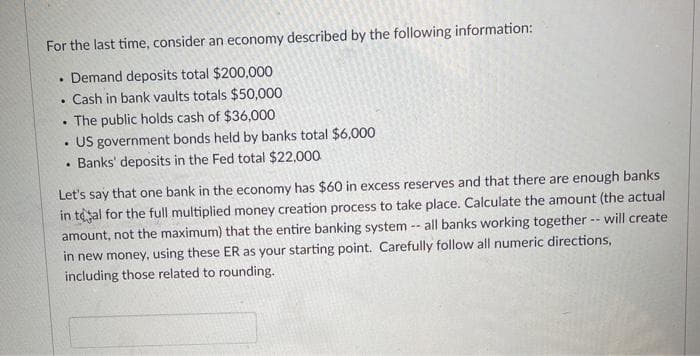For the last time, consider an economy described by the following information: Demand deposits total $200,000 • Cash in bank vaults totals $50,000 The public holds cash of $36,000 US government bonds held by banks total $6,000 Banks' deposits in the Fed total $22,000 Let's say that one bank in the economy has $60 in excess reserves and that there are enough banks in tosal for the full multiplied money creation process to take place. Calculate the amount (the actual amount, not the maximum) that the entire banking system -- all banks working together -- will create in new money, using these ER as your starting point. Carefully follow all numeric directions, including those related to rounding.
For the last time, consider an economy described by the following information: Demand deposits total $200,000 • Cash in bank vaults totals $50,000 The public holds cash of $36,000 US government bonds held by banks total $6,000 Banks' deposits in the Fed total $22,000 Let's say that one bank in the economy has $60 in excess reserves and that there are enough banks in tosal for the full multiplied money creation process to take place. Calculate the amount (the actual amount, not the maximum) that the entire banking system -- all banks working together -- will create in new money, using these ER as your starting point. Carefully follow all numeric directions, including those related to rounding.
Macroeconomics: Private and Public Choice (MindTap Course List)
16th Edition
ISBN:9781305506756
Author:James D. Gwartney, Richard L. Stroup, Russell S. Sobel, David A. Macpherson
Publisher:James D. Gwartney, Richard L. Stroup, Russell S. Sobel, David A. Macpherson
Chapter13: Money And The Banking System
Section: Chapter Questions
Problem 17CQ
Related questions
Question

Transcribed Image Text:For the last time, consider an economy described by the following information:
Demand deposits total $200,000
Cash in bank vaults totals $50,000
• The public holds cash of $36,000
US government bonds held by banks total $6,000
Banks' deposits in the Fed total $22,000
Let's say that one bank in the economy has $60 in excess reserves and that there are enough banks
in tesal for the full multiplied money creation process to take place. Calculate the amount (the actual
amount, not the maximum) that the entire banking system -- all banks working together -- will create
in new money, using these ER as your starting point. Carefully follow all numeric directions,
including those related to rounding.
Expert Solution
This question has been solved!
Explore an expertly crafted, step-by-step solution for a thorough understanding of key concepts.
Step by step
Solved in 2 steps

Knowledge Booster
Learn more about
Need a deep-dive on the concept behind this application? Look no further. Learn more about this topic, economics and related others by exploring similar questions and additional content below.Recommended textbooks for you

Macroeconomics: Private and Public Choice (MindTa…
Economics
ISBN:
9781305506756
Author:
James D. Gwartney, Richard L. Stroup, Russell S. Sobel, David A. Macpherson
Publisher:
Cengage Learning

Economics: Private and Public Choice (MindTap Cou…
Economics
ISBN:
9781305506725
Author:
James D. Gwartney, Richard L. Stroup, Russell S. Sobel, David A. Macpherson
Publisher:
Cengage Learning

Essentials of Economics (MindTap Course List)
Economics
ISBN:
9781337091992
Author:
N. Gregory Mankiw
Publisher:
Cengage Learning

Macroeconomics: Private and Public Choice (MindTa…
Economics
ISBN:
9781305506756
Author:
James D. Gwartney, Richard L. Stroup, Russell S. Sobel, David A. Macpherson
Publisher:
Cengage Learning

Economics: Private and Public Choice (MindTap Cou…
Economics
ISBN:
9781305506725
Author:
James D. Gwartney, Richard L. Stroup, Russell S. Sobel, David A. Macpherson
Publisher:
Cengage Learning

Essentials of Economics (MindTap Course List)
Economics
ISBN:
9781337091992
Author:
N. Gregory Mankiw
Publisher:
Cengage Learning

Brief Principles of Macroeconomics (MindTap Cours…
Economics
ISBN:
9781337091985
Author:
N. Gregory Mankiw
Publisher:
Cengage Learning

Exploring Economics
Economics
ISBN:
9781544336329
Author:
Robert L. Sexton
Publisher:
SAGE Publications, Inc
